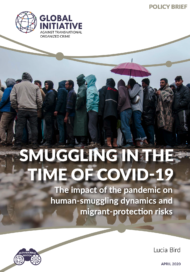Posted on 24 Feb 2020
China’s response to COVID-19 shows it has the capacity to fight the illegal wildlife trade – but is there sufficient political will?
The COVID-19 (‘coronavirus’) outbreak has raised considerable medical concern worldwide, although the effects extend well beyond the public-health domain. International supply chains are severely impacted, and could cost the global economy as much as US$1 trillion.
But if China has been losing international face following COVID-19, it is now at a crossroads where a sufficient show of political will could help to halt some of the reputational damage and, more crucially, prevent a similar outbreak from occurring in future.
Like SARS, MERS, various avian flus, ebola and most likely HIV (although that is disputed), COVID-19 is a zoonotic virus, transmitted from animals to humans. It reportedly originated from the Huanan Seafood Market in Wuhan – a so-called ‘wet market’ where an exotic array of live and dead animals are sold.
In a press release from the South China Agricultural University, pangolins are identified as a possible intermediate host. Yet this remains unproven and the evidence has not been published.
Pangolins are said to be the world’s most highly trafficked mammal, and all eight species are listed under Appendix I of the Convention on International Trade in Endangered Species (CITES), which prohibits their international trade and confirms their status as threatened with extinction. In China, there is still a huge market for their scales (used in traditional Chinese medicine and in decorative objects) and meat (as a delicacy, but also linked to perceived medicinal properties). While eating pangolins is illegal, the government continues to allow a permitted domestic trade in pangolin scales from government stocks for use in medicine. The full quantities and provenance of scales held in these stockpiles has not been divulged.
It is unclear how COVID-19 links might affect the pangolin trade. At best, it could serve to reduce demand – or at worst, lead people to destroy pangolins out of fear. Some conservation and animal-rights organizations have vociferously embraced the possible connection as an amplified call for cracking down on Chinese wildlife markets. Yet the data may still point to another host, and misplaced fervour could end up harming anti-trafficking campaigns. Actors in this space would do well to respond with caution and a clear commitment to evidence-based interventions.
In the wake of the virus, China announced a temporary ban on wildlife trade (until ‘the epidemic situation is lifted nationwide’ – according to the official order). The SARS outbreak in 2003 saw a similar move, but once infections stabilized, the ban was lifted and it was business as usual. Wildlife traders are now hoping for the same.
Although valid lessons are to be drawn from SARS, the context surrounding COVID-19 is also very different.
China overtook Japan as the world’s second-largest economy in 2010, and now accounts for 16% of global GDP – as opposed to 4% in 2003. That means if the proverbial butterfly flutters its wings (or has its caterpillar served on a menu) in this economic powerhouse, the impact across the rest of the world is more immediate, more drastic and possibly more lasting. Economists still hope for a sharp V-shaped recovery in markets once the outbreak has peaked, but others predict a slower, U-shaped outlook – or a different scenario altogether. On the health front, it could take months, or even years, to develop potential vaccines.
In the interim, China’s policy responses must sustainably and appropriately address wildlife trade and consumption, as these are at the centre of the COVID-19 outbreak – and indeed some of the deadliest health crises ever to have occurred. (According to some reports, wildlife is responsible for 70% of all emerging diseases.)
Increasingly, there are calls for the wildlife trade ban to be made permanent – not only from conservationists, but also from some Chinese citizens. ‘There’s a huge appetite for policy change among the public. On social media, legal professors and academics are engaging in a huge amount of discussion on this at the moment – including proposals to ban or severely restrict any trade in wildlife and wildlife farming – so there really is an opportunity for change,’ says Aron White, a wildlife campaigner and China specialist at the Environmental Investigation Agency (EIA).
Although there are fears that a total ban may fuel an ‘intractable, uncontrolled and highly priced illegal trade’, White says a comprehensive prohibition can signal a much-needed, high-level call for wildlife consumption to change. ‘The biggest impact a comprehensive prohibition could have for species such as tigers and rhinos is on demand: sending a message that consuming these products is not acceptable. Chinese legislation on most of these species has been ambiguous and fails to condemn the consumption of species that cannot withstand commercial-level consumption.’
White points out that China’s current Wildlife Protection Law is riddled with loopholes and vague language, meaning the law is a ‘wide open door’ for commercial trade in species that need to be protected. The law was first implemented in 1988 and has been revised three times. The most recent major revision took place in 2016, but the process failed to mark a clear shift away from a consumptive attitude to wildlife.
On 24 February, the Standing Committee of China’s National People’s Congress – China’s top legislature – met to discuss another revision. This is a crucial opportunity for China: and one for which it has paid a very price.
Along with other organizations, the EIA has urged China to seize this moment to prohibit all wildlife trade and consumption – including ‘as medicine, healthcare tonics or decorative items and including parts and derivatives from captive-bred specimens’.
The same attitudes and regulatory shortcomings that enable the likes of Wuhan’s Huanan market have allowed the illegal wildlife market to thrive. And like the COVID-19 virus, the effects are felt across the globe.
Wildlife crime is among the most lucrative forms of transnational organized crime. A recent World Bank report estimates the global cost of illegal logging, fishing and wildlife trade at a staggering US$1 trillion or more a year. Chinese consumers form a key market for illicit plant and animal products, and what China does next will affect human and animal populations worldwide.
China has been criticized for being opaque about the outbreak and for dismissing early warnings as rumour-mongering. Yet the temporary ban led to a massive crackdown on wildlife markets, showing that capacity can be mobilized rapidly to respond to policy change. A Xinhua article reports that between 21 January and 6 February, Chinese officials paid ‘nearly 1.5 million inspection visits to markets across the country’, closed over 3 700 markets and isolated ‘over 16 000 breeding sites’.
It seems clear there is sufficient capacity to address illegal wildlife-trade markets. Now is the time for China to show it also has the political will.



